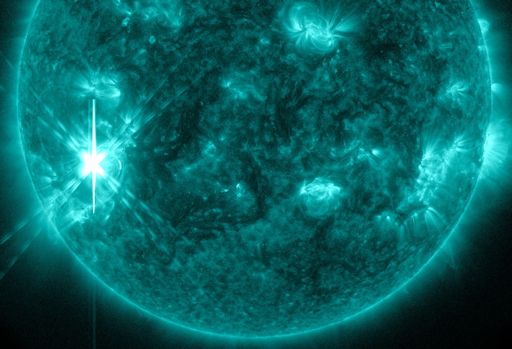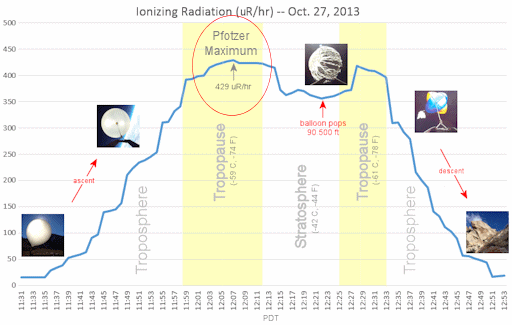SUNSET PLANETS: When the sun goes down tonight, step outside and look southwest. Venus and the crescent Moon are having a get-together, less than 10o apart. Try to catch them before the sky fades to black. A Moon-Venus pair surrounded by twilight-blue is one of the prettiest sights in the heavens. [sky map] [photo gallery]
SOLAR FLARE CAUSES RARE 'MAGNETIC CROCHET': On Nov. 5th at 22:12 UT, the magnetic canopy of sunspot AR1890 erupted, producing a brief but intense X3-class solar flare. NASA's Solar Dynamics Observatory recorded the extreme ultraviolet flash:
Radiation from the flare caused a surge in the ionization of Earth's upper atmosphere--and this led to a rare magnetic crochet. Alexander Avtanski observed the effect using a homemade magnetometer in San Jose, California. A magnetic crochet is a disturbance in Earth's magnetic field caused by electrical currents flowing in air 60 km to 100 km above our heads. Unlike geomagnetic disturbances that arrive with CMEs days after a flare, a magnetic crochet occurs while the flare is in progress. They tend to occur during fast impulsive flares like this one.
More eruptions are in the offing. NOAA forecasters estimate a 45% chance of M-class solar flares and a 10% chance of X-flares on Nov. 6th. Solar flare alerts: text, voice.
Realtime Space Weather Photo Gallery
RE-DISCOVERING THE PFOTZER MAXIMUM: On Oct. 27th, when the students of Earth to Sky Calculus launched a pair of radiation sensors to the stratosphere onboard a helium balloon, they didn't know what to expect. This just in: They have re-discovered the Pfotzer Maximum. Most people have never heard of it. The Pfotzer Maximum is a layer of peak radiation about 20 km above Earth's surface. Take a look at this data plot from the team's space weather balloon and keep reading below for more information:
The plot shows a complete profile of ionizing radiation between 2.7 km and 27 km above Earth's surface. Data from their sensor counted X-rays and gamma-rays in the energy range 10.0 KeV to 20.0 MeV. A peak in radiation levels occured in the tropopause--that's the Pfotzer Maximum.
When cosmic rays crash into Earth's atmosphere, they produce a spray of secondary particles. With increasing depth in the atmosphere, the primary cosmic radiation component decreases, whereas the secondary radiation component increases. This complex situation results in a maximum of the dose rate at an altitude of ~20 km, the so-called "Pfotzer maximum," named after physicist George Pfotzer who discovered the peak using balloons and Geiger tubes in the 1930s.
The Earth to Sky experiment was prompted by a recent NASA report concerning the effects of space weather on aviation. Like astronauts, ordinary air travelers can be exposed to significant doses of radiation when the sun is active. Data collected by balloon-borne sensors can be used to check and improve research models of radiation percolating through Earth's atmosphere.
The students are ready to fly their sensors again. A radiation storm in the week ahead is a possibility as solar activity remains high. If one erupts, they plan to revisit the Pfotzer Maximum to find out how it reacts. Stay tuned. Solar flare alerts: text, voice.

Solar wind
speed: 351.8 km/sec
density: 5.4 protons/cm3
explanation | more data
Updated: Today at 1717 UT
X-ray Solar Flares
6-hr max: M3 1346 UT Nov06
24-hr: X3 2212 UT Nov05
explanation | more data
Updated: Today at: 1700 UT
![]()
Daily Sun: 06 Nov 13
Big sunspot AR1890 has a 'beta-gamma-delta' magnetic field that harbors energy for X-class solar flares. Credit: SDO/HMI
![]()
Sunspot number: 134
What is the sunspot number?
Updated 06 Nov 2013
Spotless Days
Current Stretch: 0 days
2013 total: 0 days (0%)
2012 total: 0 days (0%)
2011 total: 2 days (<1%)
2010 total: 51 days (14%)
2009 total: 260 days (71%)
Since 2004: 821 days
Typical Solar Min: 486 days
Update 06 Nov 2013
The Radio Sun
10.7 cm flux: 149 sfu
explanation | more data
Updated 06 Nov 2013
![]()
Current Auroral Oval:
Switch to: Europe, USA, New Zealand, Antarctica
Credit: NOAA/POES
![]()
Planetary K-index
Now: Kp= 1 quiet
24-hr max: Kp= 2 quiet
explanation | more data
Interplanetary Mag. Field
Btotal: 5.8 nT
Bz: 1.8 nT north
explanation | more data
Updated: Today at 1716 UT
![]()
Coronal Holes: 05 Nov 13
Solar wind flowing from the indicated coronal hole could reach Earth on Nov. 7-8. Credit: SDO/AIA.






